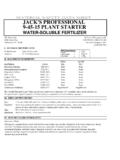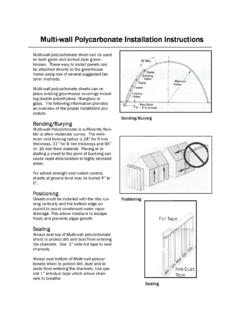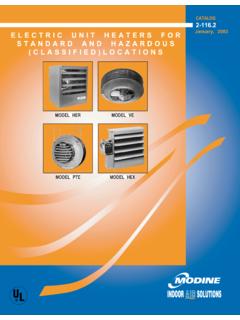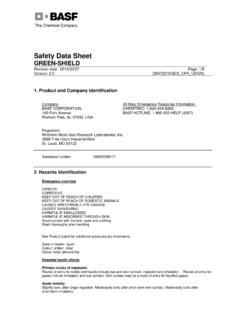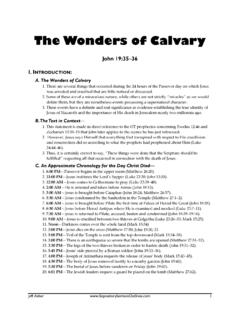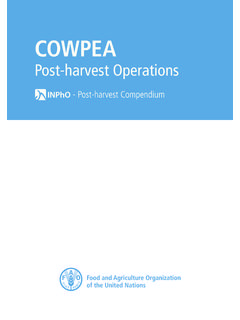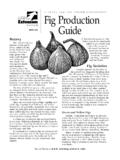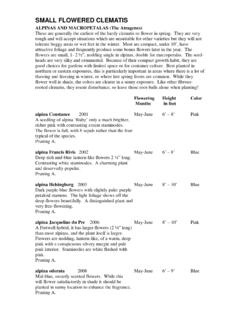Transcription of Jack's Classic All Purpose 20-20-20
1 Peters, Case of Emergency call:6656 Grant WayCHEMTREC: 800-424-9300 Allentown, PA 18106 For non-Emergency calls: 1-610-395-7104I. MATERIAL IDENTIFICATIONP roduct Name: Jack's ClassicAnalysis: 20-20-20 II. HAZARDOUS INGREDIENTSOSHAACGIHMATERIALCAS # PEL TLV Urea57-13-6 NoneNonePotassium Nitrate7757-79-1 NoneNone (containing up to 5% sodium nitrate)7631-99-4 NoneNoneMonopotassium Phosphate7778-77-0 NoneNoneCitric Acid15245-12-2 NoneNoneBoric Acid10043-35-3 NoneNoneCopper EDTA14025-15-1 NoneNoneManganese EDTA15375-84-5 NoneNoneIron EDTA15708-41-5 NoneNoneZinc EDTA14025-21-9 NoneNoneAmmonium Molybdate12027-67-75mg(Mo)/m35mg(Mo)/m3 III.
2 FIRST AID PROCEDURESEyes:Ingestion:Skin: Inhalation:IV. HEALTH HAZARD INFORMATIONS ummary of Risks Jack's ClassicAll Purpose20-20-20 MATERIAL SAFETY DATA SHEETIf in eyes, flush with water for 15 minutes holding eyelids open. Get medical attention if irritation give anything by mouth to an unconscious or convulsing person. Have conscious person drink 1 to 2 glasses of water, then induce repeated vomiting until vomit is clear. Call with plenty of soap and Hazard Ratings Health Flammability Reactivity 0 Least 1 Slight 2 Moderate 3 High 4 Severe202 Remove to fresh air. Treat ACGIH Threshold Limit Values for nuisance (inert) dusts containing <1% crystalline silica and no asbestos are: 10 mg/m3 total, 5 mg/m3 respirable.
3 Product coating is expected to minimize airborne or repeated direct contact with fertilizer may irritate eyes and skin. Inhalation of dust may irritate nose, throat, and lungs. Prolonged exposure may cause weakness, depression, headache, mental impairment, anemia, methemoglobinemia, and kidney injury. Ingestion of product can cause severe gastrointestinal irritation, muscular weakness, and blue-tinged skin (cyanosis). Infants and children are especially at risk for cyanosis. Ingestion of large amounts may result in Name: Jack's Classic All Purpose 20-20-20 Page 2 of 3 Medical conditions which may Skin abrasions and sores. be aggravated by contact:Inhalation of dust may aggravate Organs:Skin, eyes, respiratory tract, gastrointestinal tract, and central nervous Entry Route(s):Ingestion, Effect(s):Acute Effect(s):Excessive inhalation of dust may cause irritation and coughing.
4 Prolongedskin contact with product may cause mild Listed as a CarcinogenIARC Monographs:NoNTP:NoOSHA:NoV. PERSONAL PROTECTION AND PRECAUTIONSG oggles:Gloves:Respirator:Workplace ConsiderationsVentilation:Safety Stations:VI. PHYSICAL HAZARD INFORMATIONF lammable Limits (% in Air):N/AColor:Aqua-blue powder Extinguishing Media:WaterOdor:Slight yeasty odorAuto Ignition Temperature:N/ABoiling Point:Decomposes on heatingFlash Point (method):Decomposes on heatingSolubility in H20100% @ 180 FSpecific Gravity:(H20 = 1) lbs/ft3 Vapor Pressure:Not KnownEvaporation Rate:N/ (10% solution)None required for routine use as fertilizer. High airborne dust levels or mists of product dissolved in liquid may be irritating; use chemical required for normal use.
5 If prolonged or repeated use irritates skin, use neoprene or PVC airborne dust levels are high or product does not remain intact, use a combination of engineering controls ( ventilation) and personal protection ( NIOSH/MSHA approved respirator for dusts, mists, and fumes) to reduce exposures to acceptable water should be available in case material gets in and personal protection are recommended whenever dust levels are high or product does not remain Protective equipmentOne experimental study of mice and rats fed large doses of urea (394 gm/kg and 821 gm/kg over a period of one year) produced tumors of the blood-forming organs. Human reproductive effects have been reported at high doses by intraplacental route.
6 Mutagenic effects are also is moderately toxic by ingestion. It may cause headache, nausea, and vomiting. Other possible effects are disorientation, nervousness, hypertension, hypothermia, and cardiac effects. A study of 67 workers in an environment with high airborne concentrations of urea found a high incidence of protein metabolism disturbances, moderate emphysema, and chronic weight Name: Jacks Classic 20-20-20 Page 3 of 3 ReactivityStability:Stable Hazardous Polymerization:Will Not Occur Conditions to Avoid:Hazardous Decomposition Products:Chemical Incompatibilities:Unusual Fire, Explosion and Reactivity Hazards:In Case of Fire:VII.
7 REGULATORY INFORMATIONDOT Classification:Not DOT STORAGE AND SPECIAL PRECAUTIONSP recautions to be taken in handling and storageIn case of spillsWaste Management/Disposal Rev. 12/18/2006 Date Issued:1/1/1999In a fire, oxides of nitrogen, potassium, and carbon as well as ammonia, biuret, and cyanuric acid are possible. Avoid dusting or misting conditions during cleanup. If material is uncontaminated, collect and reuse as recommended for product. If contaminated, put in appropriate container and dispose. Keep spills away from drinking water supplies. After cleaning up spill, flush area with heat. Contact with strong alkalies, oxidizers, and reducing agents.
8 Contact with fuels and other organic or combustible materials. Active metals such as aluminum and magnesium. Strong alkalies and reducing agents. Sodium are incompatible with strong alkalies and reducing agents, active metals (such as aluminum and magnesium), ammonia, organic, and combustible product is comprised of materials which are oxidizers in their pure, unmixed forms. It will not burn but can provide oxygen for existing fires and cause combustible materials to ignite in a cool, dry area away from incompatible materials and heat sources. Store away from feed and foodstuffs, as well as household cleaning products. Wash hands with soap and water after handling product.
9 Keep out of reach of area. Flood with water to cool containers. Apply water from a safe distance to avoid splattering of molten material. Wear self-contained breathing apparatus to fight large as fertilizer to field. If product is contaminated, dispose of in an approved landfill disposal facility, in accordance with applicable federal, provincial, and local decomposes on heating to emit toxic oxides of nitrogen, carbon, and potassium as well as ammonia, biuret, and cyanuric acid. High airborne dust concentrations have the potential for phosphate is incompatible with sodium is incompatible with strong oxidizers alkalies, sodium nitrite, and many chlorine compounds (including bleach and other household cleaning products).



